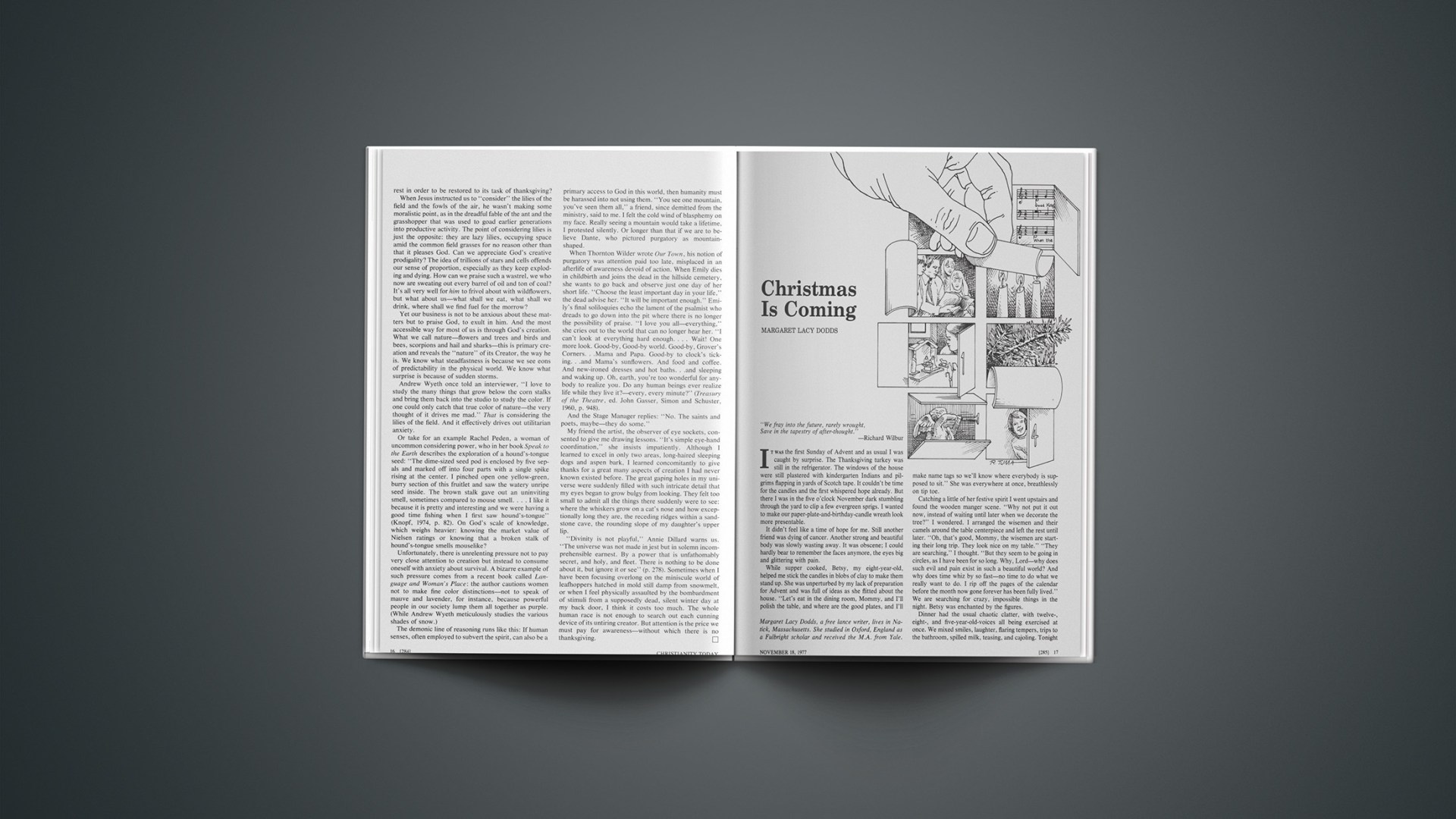“We fray into the future, rarely wrought,
Save in the tapestry of after-thought.”
—Richard Wilbur
It was the first Sunday of Advent and as usual I was caught by surprise. The Thanksgiving turkey was still in the refrigerator. The windows of the house were still plastered with kindergarten Indians and pilgrims flapping in yards of Scotch tape. It couldn’t be time for the candles and the first whispered hope already. But there I was in the five o’clock November dark stumbling through the yard to clip a few evergreen sprigs. I wanted to make our paper-plate-and-birthday-candle wreath look more presentable.
It didn’t feel like a time of hope for me. Still another friend was dying of cancer. Another strong and beautiful body was slowly wasting away. It was obscene; I could hardly bear to remember the faces anymore, the eyes big and glittering with pain.
While supper cooked, Betsy, my eight-year-old, helped me stick the candles in blobs of clay to make them stand up. She was unperturbed by my lack of preparation for Advent and was full of ideas as she flitted about the house. “Let’s eat in the dining room, Mommy, and I’ll polish the table, and where are the good plates, and I’ll make name tags so we’ll know where everybody is supposed to sit.” She was everywhere at once, breathlessly on tip toe.
Catching a little of her festive spirit I went upstairs and found the wooden manger scene. “Why not put it out now, instead of waiting until later when we decorate the tree?” I wondered. I arranged the wisemen and their camels around the table centerpiece and left the rest until later. “Oh, that’s good, Mommy, the wisemen are starting their long trip. They look nice on my table.” “They are searching,” I thought. “But they seem to be going in circles, as I have been for so long. Why, Lord—why does such evil and pain exist in such a beautiful world? And why does time whiz by so fast—no time to do what we really want to do. I rip off the pages of the calendar before the month now gone forever has been fully lived.” We are searching for crazy, impossible things in the night. Betsy was enchanted by the figures.
Dinner had the usual chaotic clatter, with twelve-, eight-, and five-year-old-voices all being exercised at once. We mixed smiles, laughter, flaring tempers, trips to the bathroom, spilled milk, teasing, and cajoling. Tonight “finish your peas” was followed by “now everyone try to be quiet while we light the first candle, just like in church.” “We’re having church here? Yuk!” scowled Mike, the youngest. But for a few minutes quiet did reign, as Katy stumbled through a passage from Jeremiah. (“Should have checked that one out before,” I thought. “Too hard for kids—one more loose end.”) The poem that followed proved to be beyond them as well. “What in the world does that mean?” all three asked in bewilderment.
My heart sank. This golden moment to transmit the faith to our children was fast slipping away from us. We weren’t prepared. We hadn’t taken time to aim each word at their level. The ritual was mere adult words, hitting them from an alien world. We opened the first window of the Advent calendar. An angel. Another incomprehensible symbol. I didn’t want to talk about angels. But we could sing about them, and “Angels we have heard on high,” with its wonderful roller coaster Latin chorus, was belted out with gusto, even though the children didn’t fully understand the words.
We decided to sing one more carol and someone shouted for “Away in a Manger.” At this Mike came to life. It was one of his “good-night” songs, part of the bedtime ritual we had evolved over the years with each child. He knew every word and his voice could be heard above all the others: “… lead us to heaven to dwell with Thee there.” He had begun asking lots of questions this year about heaven. “Is that where we’re going, where little-Lord-Jesus is leading us?” His eyes were bright and intense. “Yes,” I said, and my choked voice stopped in awe at the way revelation breaks in upon us. “And that’s what the wisemen and their camels are looking for, too.” “And,” I thought with an aching heart, “it’s what Sammie, and Betty, and now Ernie look for, and I pray to God are finding, in their agony of dying.”
Mike jumped up with a shout to grab the candle snuffer for his turn to extinguish the flame. Then he raced into the living room with the others to place the remaining figures in our simple creche. With much laughing and arguing donkeys and shepherds were put into position. Then came the stricken cry, “Where’s the baby Jesus? He’s not in the bag.” All three children got on their hands and knees and rummaged through the tissue paper scattered over the floor. There he was, the tiny wooden figure carved of Jordanian olivewood—so small, so easily hidden in the chaos, but without him the whole scene was empty, the celebration meaningless. Betsy placed him gently on the tiny wooden crib. And then Mike appeared with his own addition, a small wooden Santa Claus racing on tip toe, holding high a Christmas tree. “That doesn’t belong there!” his sisters protested with grown-up indignation. “Yes it does,” he insisted stubbornly. “Because we found the little-Lord-Jesus. And (his face broke into a beautiful smile) because Christmas is coming.”
Yes—on tip toe, pell mell, and in spite of human pain and human clumsiness. In the most marvelous and unexpected ways, Christmas is coming. Even so, come, Lord Jesus.
D. Bruce Lockerbie is chairman of the Fine Arts department at The Stony Brook School, Stony Brook, New York. This article is taken from his 1976 lectures on Christian Life and Thought, delivered at Conservative Baptist Theological Seminary in Denver, Colorado.










